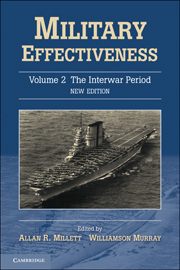Book contents
- Frontmatter
- Contents
- List of Contributors
- Introduction: Military Effectiveness Twenty Years After
- Maps
- 1 The Soviet Armed Forces in the Interwar Period
- 2 The French Armed Forces, 1918–40
- 3 The Military Effectiveness of the US Armed Forces, 1919–39
- 4 The British Armed Forces, 1918–39
- 5 Japanese Military Effectiveness: The Interwar Period
- 6 The Italian Armed Forces, 1918–40
- 7 German Military Effectiveness between 1919 and 1939
- 8 Military Effectiveness of Armed Forces in the Interwar Period, 1919–41: A Review
- Index
8 - Military Effectiveness of Armed Forces in the Interwar Period, 1919–41: A Review
Published online by Cambridge University Press: 05 June 2012
- Frontmatter
- Contents
- List of Contributors
- Introduction: Military Effectiveness Twenty Years After
- Maps
- 1 The Soviet Armed Forces in the Interwar Period
- 2 The French Armed Forces, 1918–40
- 3 The Military Effectiveness of the US Armed Forces, 1919–39
- 4 The British Armed Forces, 1918–39
- 5 Japanese Military Effectiveness: The Interwar Period
- 6 The Italian Armed Forces, 1918–40
- 7 German Military Effectiveness between 1919 and 1939
- 8 Military Effectiveness of Armed Forces in the Interwar Period, 1919–41: A Review
- Index
Summary
Introduction
The definition of the word interwar had a different meaning for most of the seven military organizations under study. Though the year 1919 was the baseline for all, Japan had been fighting an all-out war against China since 1937; France and Britain were at war with Germany in 1939; Italy entered the hostilities in 1940; Soviet Union was invaded by Germany in June 1941; and the United States only went to war in December 1941.
The cast of national characters was importantly different from the alignments of the First World War. Two victors of 1918 – Italy and Japan – had opted to reverse themselves and become the allies of a vanquished state, Germany. Russia, under new management as the Soviet Union since 1917, ended up fighting on the same Allied side once chosen by the last Romanov tsar. The United States, too, found itself again the comrade in arms of its former Allies, England, France, and Russia.
Britain was still a constitutional monarchy in 1939, though it had had a series of prime ministers between the days of Lloyd George and of Winston Churchill. Under the Third Republic of France, there had been a succession of premiers between Clemenceau and Daladier. In Japan, the same emperor held the throne; though a general, Terauchi, led off the period as prime minister. He had had twenty-two successors by 1941, the last being another general, Tōjō, by October of that fateful year.
- Type
- Chapter
- Information
- Military Effectiveness , pp. 256 - 270Publisher: Cambridge University PressPrint publication year: 2010



